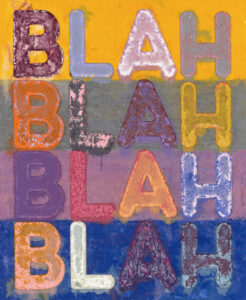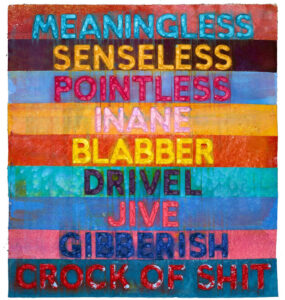The context in which Mel Bochner’s personality and then artistic research was formed belongs to the Sixties and Seventies. Those were years of great social upheavals, marches in favor of peace, protests for the claim of minority rights and, let’s face it, it was a historical moment also based on the great illusion for a future full of joy and happiness. Not a secondary fact, in the artistic field, in the United States we were witnessing a turning point around the consolidation of Pop Art into a system of power and when this happens we always know that other ferments are about to become operational.

Mel Bochner, Blah, Blah, Blah, 2022. Monoprint in oil with collage, engraving and embossment on handmade paper. Paper dimensions: 69,2 x 57,2 cm, ph courtesy Metroquadro
Mel Bochner belongs to that generation of artists who have embodied the banners of minimalism and conceptualism, trying to break with the traditional schemes of painting. His traveling companions were artists such as Eva Hesse, Donald Judd, Robert Smithson and Bruce Nauman. In particular, Mel Bochner has concentrated his work on linguistic analysis, on the schematic of words, on set phrases, on the pictorial translation of syllabifications and symbolic words, so much so that the subsequent works on the text by Jenny Holzer and Barbara Kruger boast an unrecognized but undeniable debt. His pioneering introduction to the use of language in the visual field led art historian Benjamin H. D. Buchloh to describe his 1966 Working Drawings as the first conceptual record. The installation to which Buchloch refers is the one that the author exhibited at the School of Visual Arts in New York. The full title of the exhibition was “Working Drawings and Visible Things on Paper Not Necessarily Meant to be Viewed as Art” and its length rightfully places it within that philosophy of art where thinking was worth more than producing, the the strangeness of the proposal was worth more than its configuration, the layout was worth more than the single graphic sign.

Mel Bochner, Money, 2022. Monoprint in oil with collage, engraving and embossment on handmade paper. Paper dimensions: 75,9 x 51,4 cm, ph courtesy Metroquadro
The exhibition consisted of photocopies of design drawings (but not only) that he had requested from his artist friends (Donald Judd, Carl Andre, Dan Flavin, Sol LeWitt, Eva Hesse, Dan Graham, Jo Baer, Robert Moskowitz, Robert Smithson, Al Jensen, just to name a few) and which were exhibited in four folders with black covers arranged on white parallelepipeds. A dry, simple, poor exhibition to be leafed through. Among the various photocopies, a $3,051.16 invoice from Donald Judd was also exhibited. Strictly speaking, Working Drawings was not recognizable as an artistic work and perhaps it did not want to be or, at least, it did not claim to be placed within a traditional sequence of Renaissance derivation. In reality he shifted the axis of the horizon, looking at the process located in the development of ideas and at their location in space.

Mel Bochner, Meaningless, 2016. Monoprint with collage, engraving and embossment on hand-dyed Twinrocker handmade paper. Image dimensions: 44,5 x 40,6 cm, ph courtesy Metroquadro
The shadow of Duchamp is obviously present, like a noble father of all the art from those years. Indeed, in conceptual art, Sol LeWitt explained that the ideas or concepts are the most important aspect of the work (“Paragraphs on Conceptual Art”). LeWitt also stated that in conceptual art, all planning and decisions are made in advance and execution is only a secondary aspect. But the Working Drawings while opposing the material processes of traditional art, were not entirely planned or decided in advance. Therefore, the Working Drawings also present some aspects in common with the “anti-form” model that will be theorized by Robert Morris, where it is argued that there could be a disconnect between conception and creation; let’s also say that a minimal work was certainly not “irrational” but could be “reasonable” and “well constructed”. Let’s even say solid, like those first four parallelepipeds by Bochner which actually marked the history of that decade.

Mel Bochner, Ha, 2016. Monoprint with collage, engraving and embossment on hand-dyed Twinrocker handmade paper. Image dimensions: 21,6 x 25,4 cm, ph courtesy Metroquadro
Bochner was born in Pittsburgh in 1940, but he soon understood that the center of art in America was New York and he moved there in 1964, and still resides there. His work, still focused on linguistic analysis, underwent a progressive development over the years: in particular, the hard black and white of his first works slowly faded to let color preponderate, as a sensual and engaging charge. In reality this is a process that involved all the artists from those years to a certain extent: the seminal and ideological hardness of the 1970s peels off and smoothes out in a riot of chromatic songs in the following decade. Just think, as a term of comparison, of the first photos of Gilbert & George’s “Singing Sculpture” and their subsequent epiphanies: an abyss.

Mel Bochner, Obscene, 2013. Monoprint with collage, engraving and embossment on hand-dyed Twinrocker handmade paper. Image dimensions: 30,5 x 22,9 cm, ph courtesy Metroquadro
As proof of his role within those radical upheavals, Bochner boasts an endless series of exhibitions in private galleries and is present in the permanent collections of the MET, MoMA and the Whitney Museum in New York, the Tate Modern in London, the National Gallery in Washington, MOCA in Los Angeles, Centro de Arte Reina Sofia in Madrid. In Italy it was presented for the first time in 1970, in Turin by the Galleria Sperone and in Milan by the Galleria Toselli. Now, in Turin, at Metroquadro, Bochner returns for his fifth solo exhibition in this gallery and for this occasion his latest works on paper will be presented: monotypes with collage together with engravings. Mel Bochner began working on the monotypes in 1994, partly for the recovery of a technique that has gone out of fashion and partly for the surprise that the monotype reserves in the fading of the outlines. The work on the letter does not change and reveals a certain assonance with the component writing of Alighiero and Boetti. The boundaries are those of the page and the line and this is the constraint of each of his sentences, as are the square boxes in Boetti’s words. Space thus becomes the bond of meaning and of the message that can be transmitted.

Mel Bochner, That’s All Folks!, 2014. Etching with aquatint, edition 4 of 20. Image dimensions: 56,5 x 76,8 cm, ph courtesy Metroquadro
Once this problem has been solved, the reorganization based on color combinations and the perception of individual words begins. But the author does not always want to dominate the entire creative process: sometimes he grants his collaborators the possibility of some variations, just as Mark Kostabi gets the titles of his paintings proposed by the people he meets. In this way, an art that wants to be radically conceptual opens up to the uncertainty of the result, so that chance and fate enter the final phase of the work. Moreover, this Metroquadro initiative will fall within the Exhibi.to OPEN GALLERY WEEKEND project, the Turin event which will take place on 21, 22 and 23 September, somewhat along the lines of the “collective vernissages” which are also organized in Berlin He’s in London.
Fabio Fabris
Info:
Mel Bochner
14/09/2023 – 11 novembre 2023
Opening: giov. 14 sett. ore 18.00 – 23.00
Metroquadro
c.so San Maurizio 73 F, 10124 Torino
info@metroquadroarte.com
www.metroquadroarte.com

is a contemporary art magazine since 1980






NO COMMENT